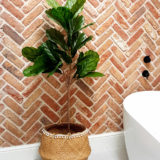Welcome to Ask Andy, the go to place for those questions that you might need the answers too.
Todays top questions are featured below:
How do you cut brick slips?
You can cut brick slips using a standard electric tile cutter.
Most brick slips come at a standard depth of 20mm, as a result most tile saws will be able to cut them.
Clay is fairly soft and so long as the right blade and cutting depth are selected brick slips are easy to work with and cut.
Wet Cutting
It is always recommended that a wet cut tile saw is used when cutting brick slips. The benefit of a wet cut tile saw is that the water acts as a dust suppressant. All debris is absorbed into the water making it a very safe way of cutting brick products. The addition of water also acts as a lubricant on the diamond saw blade, ensuring a cleaner finer and more accurate cut.
Safety
We always recommend that appropriate safety wear is worn when using any machinery. Goggles and gloves must be worn at all times when cutting. Always read the manufacturers instructions and safety advice before operating machinery.
How much adhesive do I need?
Based on a 20kg bag of Rapid setting adhesive at a notched trowel depth of 6mm.
One bag of adhesive would cover an approximate brick slip area of 5m2.
Meaning every square meter would require 4kg of dry adhesive product.
Calculations are based on best case conditions.
The overall product coverage will be less on uneven walls. This is because the product is also being used as a leveling compound.
Although a general rule of calculation can be applied, the quantity of adhesive required really does depend on the overall quality of the substrate.
Best Practice
Applying flexible rapid set adhesive to the wall and to the backs of the brick slips allows for maximum strength and cure.
You should never apply adhesive directly onto bare gypsum or plastered walls. Sealed them beforehand using a PVA Primer is a must.
All product should be dust free and prepared prior to mixing the adhesive. This will give more time for fixing them on to the substrate.
Most adhesives initially cure within an hour forming a skin, you should always work quickly. Mixing smaller batches always helps minimize waste.
Do I need to leave a mortar joint?
Traditional building methods do require a mortar joint to bond bricks to each other.
During installation it is optional as to whether you want to leave a mortar joint or not, as a result some designs leave the joint bare.
Furthermore it has become more and more popular to follow the butt joint rule.
There is no right or wrong way when using brick slips as they are classed as decorative and not structural.
Standard brickwork joint
The standard brick joint size in the UK is 10mm, this is what the majority of brick slip installations use. We currently supply a special brick slip T spacer, these spacers are 10mm and can be re-used. The spacers are very versatile as they allow for small changes to the coursing.
The great thing about having a mortar joint is that it gives the installer wiggle room to get the installation perfectly in line.
No brickwork joint
Non traditional in design..installations that do not leave a joint are ever more poplar with designers. Stack bond patterns lend themselves perfectly for this look.
Due to brick slips being a decorative product the need for a mortar joint is purely decorative and has no structural significance.
Why not Ask Andy!
If you’re in doubt then give Andy a shout in the comments box below! Also, be sure to check back in here for future additions to our popular “Ask Andy” column.































Hi there
After finishing my brick slip wall there seems to be a fair bit of mortar on the bricks face, now that it’s dry how’s the best way of removing it and getting the bricks back to how they looked before I did the joints??
Cheers